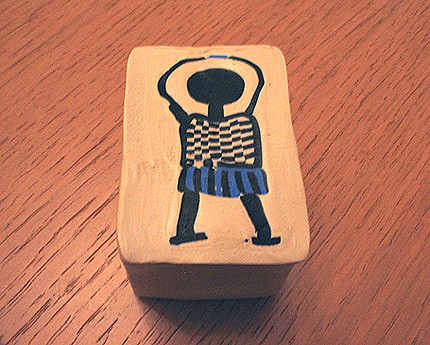
Last night a new book dropped on my doormat; Syndee Holt's Polymer Clay for the First Time. I had been looking forward to this, specifically because I had noticed there was a lesson in there about creating pictorial canes. The shaman cane particularly grabbed me, as I do have a keen interest in ancient carvings and paintings, petroglyphs, hieroglyphs etc. Creating a picture in the clay seemed particularly challenging, so I was keen to start straight away.
Fortunately I had some half used blocks of clay which were perfect for the task; sahara, black and blue. I decided to throw all caution to the wind in terms of the amount used and just conditioned whatever I had. So following the instructions in the books I started by making a checkerboard cane and then continued to construct the man by creating the head, arms and legs from black clay. It took me quite a while to construct (about 2 hours in fact) but at the end this is the result. It's a fairly large block and I used up all of my sahara, but I can see how making a large block like this means you are more likely to maintain the proportions of the picture.
I was a little disappointed with the feet because I rushed this part and of course the result is that they are not quite formed properly. However I was very careful in this case to constantly clean my hands with wipes, particularly after conditioning some dry black clay which is particularly dangerous for contaminating other colours.
The end result was fairly satisfying. The cane will need to be reduced and then I would like to add a border around it, maybe several different borders if I cut the block into pieces. I have decided to leave this piece to rest for a while before doing anymore to it, basically because I used some brand new sahara which, when conditioned, became extremely soft, so that when I cut through the core, the blade was dragging it rather than cutting it clean.
I do find that by trying out different exercises like this means I now feel more confident in my use of the clay, in understanding how to work it, how to avoid some of the basic errors I made at the start. I have learnt for example that the driest clay can be squeezed and "warmed up" in the hands and that this is a better technique than trying to condition it in the pasta machine. I find that some of the basics which seemed quite challenging at first, now don't seem so difficult once you get a better understanding of the clay.
No comments:
Post a Comment